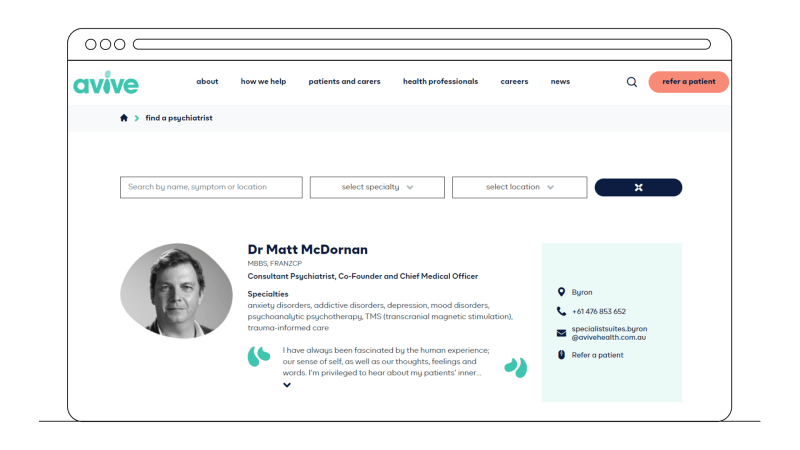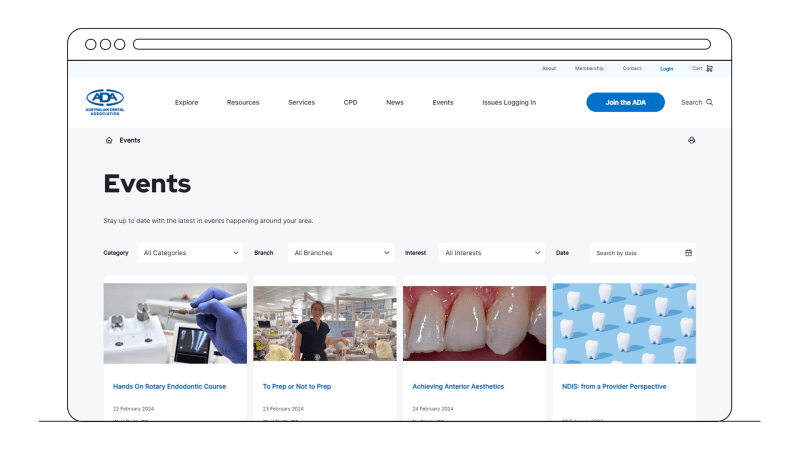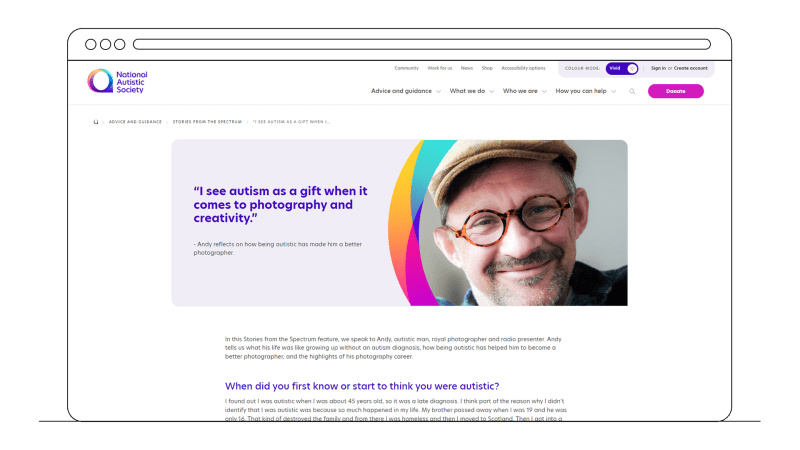Keeping consistent communication on several websites and other digital channels is a challenge for many hospitals, clinics, and health centers. Patients and clients expect a smooth user journey while professionals want to be updated on news and events. So, how do you manage web content effectively if you deal with corporate demands plus the unique needs of each brand, care and service providers?
Why it’s important to keep your website up to date
High-quality, up-to-date content on your website can save you a lot of time and hassle. Your patients can use your website to:
- Find a local care provider
- Find your health center’s address and opening times
- Book an appointment
- Read and write reviews
- Find advice on how to treat their condition
- Check if they have paid their bills
- Contact you for help
But websites in the healthcare sector don’t serve just patients. They can also be super helpful for the members of the professional community who can:
- Access exclusive content through a password-protected area
- Register for events and classes
- Download materials
- Connect with the professional community
- Keep up to date with the news in their field
If you ensure your website is informative and up-to-date, your audience will use it as a go to source of information. Consequently, it will increase trust in your services.
Examples of the most helpful healthcare website content
Your website can be a rich information hub that will provide patients, carers, doctors and the whole community with all relevant information in one place. Ensure your content is personable – it's engaging and makes the reader feel understood. Users should quickly find the support they came for. Examples of content users find especially useful are:
Care provider profiles
Provide detailed information about your staff, so patients know their doctor before they come for an appointment. It increases trust and helps with fear of the unknown. Each profile should include the doctor's name and profile picture, location, range of services, qualifications, office hours, and waiting times. The profile may also contain reviews that help others choose the right care provider.

Online appointment scheduling
According to research, 60% of Americans usually use online appointment scheduling. So, booking an appointment online is a super-convenient option for most patients. The number is even higher in the younger generation. Your CMS can be integrated with an online booking technology, so all updates appear on the website to reflect the current availability of the doctors.
Alerts
Alerts on your homepage or the whole website will quickly communicate important updates, such as emergencies, health advisories, or changes in services, ensuring patients and visitors stay informed and safe. You can set them to show to newcomers and hide them for repeat visitors.
Overview of services
Service overview is a clear, concise description of the medical services offered by the healthcare organization. It can be categorized by the condition for a patient-centric approach or by medical department (cardiology, orthopedics, pediatrics, etc.) for the professional audience. If you run a large hospital with a range of services, a powerful search function is a must for a smooth user experience.
Event and classes
If you organize events and classes, your audience will look for details on your website. You can feature a calendar and a list of events with search and filtering, so users can quickly find the right event in their area. You can send event announcements to subscribers by email to keep your visitors up to date with the next free screening, workshops, and conferences.

Health and wellness tips
The website could offer practical advice on maintaining health and wellness. These could be seasonal health tips, nutrition advice, or wellness strategies for everyday life. A section with advice on your website will help you attract visitors searching for a solution to their problem and divert them to the right doctor in your clinic.
Real-life stories
Patient success stories describe the real experiences of clients who have used your services. They can also describe what life is like with a condition and how people cope with it. Stories are extremely personable. They bring hope to families in difficult situations, offer guidance for those looking for treatment or care, and give readers the feeling that they’re not struggling alone.

Six ways to manage healthcare website content efficiently
There are many ways your website can help visitors: finding care providers and opening hours, offering advice and emotional support, collecting event registrations and donations. Managing and updating all this content can be a demanding job, especially if you have several websites, email channel, an app and social media. But there are ways to streamline the process and make it work even with limited resources.
Store all your content in one library
If you use a CMS or a digital experience platform (DXP) with a built-in content hub, you can store all your digital assets including text, images, video, files, and other media in one place. If you need to make an update, you just change the item in the content hub and it automatically updates all places where the content is used. This method helps your information stay accurate and consistent.
From the content hub, you can pull out content items such as a headline, summary, testimonial, or a profile photo anywhere on your websites, emails and social channels. For example, if there's a change in staff, you only need to update this information once in the content hub. The changes automatically apply across all connected websites and apps.
Get all your websites under one roof
If you have a corporate website and several clinics with their own content, you can manage them all from one place. Each site will have a shared part and a unique part, whether it’s the color scheme, staff and location list, articles or events. Building your website on a DXP with multisite capabilities will enable you to do just that.
You can make changes or add information to one site or all of them in one admin interface. Your colleagues from each branch can access only their part of the website.
The significant benefit of such consolidation is consistency. When you update your corporate site, you can easily keep other sites in sync. Patients and visitors get the same experience and information no matter which site they visit.
Don’t rely on developers for every step
Marketers and website editors shouldn't need the help of developers for their day-to-day work. Ensure you can manage your website independently. If you need to update your website or create a new page, a low-code/no-code platform will empower you to set everything up without a single line of code. Adding a new article, creating landing pages, or sending a newsletter can be done in an intuitive, visual editor.
Learning how to use low-code platforms is usually quite easy because technicalities are defined during implementation and then editors just need to know drag-and-dropping, clicking, and typing – things most people are comfortable with.
Give editors access to their part of the website
To maintain trust and reliability, your web content needs regular updates. The update process should be easy and quick, otherwise people will postpone it for ever.
If you restrict access to only the relevant areas, your colleagues will be able to update make updates without worrying about breaking something in the deep of the website.
If a new doctor joins your team, adding their profile promptly lets patients know about the new service, keeping opening hours or pricing up-to-date will significantly improve your clients’ experience with your health center.
Prioritize security and data protection
When patients enter their details on your website, they need to feel confident that their data is safe. A secure website shows that you take their privacy seriously and are committed to protecting their information. This is why using a platform that meets security and data protection standards is a must.
Make sure you’re always using a supported version of your technology and your editors are properly trained to use it safely. Stay secure by partnering with trusted IT providers. Implement measures such as encryption and access controls, and do regular audits.
Regularly review and optimize content
When you regularly review your content, you quickly learn what works and what doesn’t. To keep your website relevant and useful, monitor your content performance and optimize it according to the data.
Maybe some health tips are really popular, while others aren't getting much attention. Or a new treatment is available and you should update an article about the related condition. If patients are frequently asking about a specific service, you might want to make that information more prominent on your website.
Boost your website performance with smartly managed content
Transform your website into a reliable source of information for clients, members, and professionals. If you manage all your content from a single digital experience platform (DXP), you’ll ensure consistency of your brand.
Technology with intuitive interface will empower your colleagues to update their parts of content, so your information is always up to date. Plus, don’t forget to secure your content and check it regularly for quality and performance.
That way, you can build trust and loyalty with your website users. Consequently, you get better outcomes for your audience and your organization!
Learn more about how to build trust from the first contact with personalized healthcare marketing.

